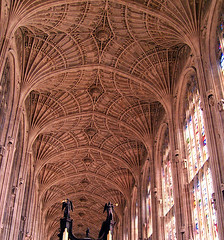Gothic architecture and style was a major influence on the Pre-Raphaelites and the Arts and Crafts movement. For the next few days, I will be examining the history of Gothic architecture and style.
If the word "goth" conjures up images of depressed mall goth teenagers wearing too much eyeliner, it's time to re-educate yourself!
The Goths were a group of five eastern Germanic tribes after the demise of the Roman Empire. They were not architects, and have no relationship to Gothic style aside from the name.
Gothic architecture itself emerged in 12th century France and was originally called "French Style." It was the dominant style between the 12th and 16th centuries, but was later mocked by some as being "Gothic"(as in backward and barbarian). The Gothic style is characterized by mathmatic precision, symmetry and a desire to reflect the glory of God through awe-inspiring architecture.
Some of the most distinctive features of the Gothic style of architecture were the flying buttresses, used to support the height of the buildings, and pointed arches (which actually originated in Assyrian and Islamic architecture). 
You can see examples of most of these features in the photo on the right. This was taken by yours truly in Summer of 2005. I miss Paris so much! Notre Dame is a great example of Gothic architecture. You can see numerous pointed arches in the photo, along with the flying buttresses that are supporting the weight and height of the building. The buttresses were essential to creating the lithe structure of the buildings, which look like fairy palaces in comparison to the heavier structure of Romanesque architecture. 
Moreover, as a result of the ribbed and vaulted ceilings they made use of, Gothic buildings were also significantly lighter and brighter inside than Romanesque structures (which is why it's kind of funny that we tend to associate anything "Gothic" with darkness). Gothic architecture was actually about creating light, bright places! This vaulted ceiling in King's College Chapel at Cambridge University illustrates the the power of the ribbed, vaulted ceiling. You can also tell from the windows on the right how this structure permitted architects to leave more room for windows. Kings College Chapel has one of the most famous and ornate vaulted ceilings in the world. I saw it in high school on a trip to England and I was absolutely dumbfounded. The sheer majesty of the architecture was breathtaking. The building was completed in 1515 under the reign of King Henry VIII.
A more detailed picture of the construction of flying buttresses can be seen below (thank you wikipedia commons!). As a side note, doesn't the very phrase "flying buttresses" sound terribly romantic? I seem to recall Anne of Green Gables saying something about them, but I can't quite remember it at the moment.
Sadly, in the wake of the Renaissance, the style police decided that Gothic architecture was abandoned. The powers that be wanted to return to a more classical style and they did for a while, but as we will see tomorrow, the enduring popularity of Gothic style led to its revival just a century later.
All images courtesy of Wikipedia Commons, save the photo of Notre Dame, which is mine!
For more information on Gothic Architecture, take a look at Yale University Press' fantastic new art history glossy, Gothic Architecture.
Thursday, April 17, 2008
Gothic Architecture
Posted by
Margaret
at
9:22 AM
![]()
![]()
Labels: architecture, medieval
Subscribe to:
Post Comments (Atom)


2 comments:
Hi Margaret!
I've just had so much fun perusing and catching up on your posts. From acanthus leaves to gothic structures, it has been a delight!
Thank you! Nancy
yep..that's exactly what came to my mind when you mentioned goth, dark lipstick and more tattoos, but you know what, most of our churches here..the one next to my daughter's school dated 1928 are all goth inspired. the last picture is awesome
Post a Comment